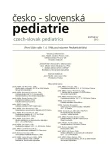-
Medical journals
- Career
Transplantation of hematopoietic cells in five patients with chronic granulomatous disease in the Czech Republic
Authors: A. Janda 1; P. Keslová 1; R. Formánková 1; J. Litzman 2; A. Šedivá 3; H. Houšťková 4; P. Rozsíval 5; E. Pařízková 5; J. Starý 1; P. Sedláček 1
Authors‘ workplace: Klinika dětské hematologie a onkologie UK 2. LF a FN Motol, Praha, přednosta prof. MUDr. J. Starý, DrSc., Ústav klinické imunologie a alergologie LF Masarykovy univerzity, FN U sv. Anny, Brno , přednosta prof. MUDr. J. Litzman, CSc., Ústav imunolog 1
Published in: Čes-slov Pediat 2012; 67 (2): 81-88.
Category: Original Papers
Overview
Chronic granulomatous disease (CGD) is a primary immunodeficiency caused by defective phagocytosis. Conservative treatment is applied in most of the patients. Currently, the only available curative treatment is allogeneic hematopoietic stem cell transplantation (HSCT).
Thirty-seven patients were diagnosed with CGD in the Czech and Slovak Republic between 1957 and 2011. Calculated incidence of the disease in the Czech Republic is 1 : 280,000 live births. Five patients with serious course of the disease underwent allogeneic HSCT in 2007–2010. Median age of CGD diagnosis in these patients was 6 months (6–17 months), median age at transplantation was 21 months (1–17 years). One patient was transplanted in myeloablative regimen, 4 patients in regimen with reduced intensity. All of the grafts were from HLA-matched unrelated donors. The procedure was complicated with graft versus host disease – GvHD (3 patients), infections (4 patients), autoimmunity (3 patients) and toxic side effects (3 patients). Median follow-up after the transplantation was 12 months (6–44 months). In all of the patients normalization of granulocyte function was documented within 2 months after the transplantation. Mixed chimerism was present in all of them. The oldest patient (transplanted at the age of 17 years, 4 months) died 6 months after transplantation due to intracranial haemorrhage after operational revision of healed brain abscess. All the other patients (4) are in a good clinical condition, without signs of CGD or GvHD.
In concordance with other transplantation centres we show that early allogeneic HSCT is a suitable treatment of patients with severe CGD.Key words:
chronic granulomatous disease, primary immunodeficiency, hematopoietic stem cell transplantation
Sources
1. Roos D, Kuijpers TW, Curnutte J. Chronic granulomatous disease, a molecular and cellular approach. In: Ochs HD, Smith E, Puck JM. Primary Immunodeficiency Diseases. Oxford: Oxford University Press, 2006 : 525–549.
2. Kang EM, et al. Chronic granulomatous disease: overview and hematopoietic stem cell transplantation. J Allergy Clin Immunol 2011; 127 (6): 1319–1326; quiz 1327–1328.
3. Marciano BE, et al. Gastrointestinal involvement in chronic granulomatous disease. Pediatrics 2004; 114 (2): 462–468.
4. Seger RA. Chronic granulomatous disease: recent advances in pathophysiology and treatment. Neth J Med 2010; 68 (11): 334–340.
5. Seger RA. Modern management of chronic granulomatous disease. Br J Haematol 2008; 140 (3): 255–266.
6. Winkelstein JA, et al. Chronic granulomatous disease. Report on a national registry of 368 patients. Medicine (Baltimore) 2000; 79 (3): 155–169.
7. Jones LB, et al. Special article: chronic granulomatous disease in the United Kingdom and Ireland: a comprehensive national patient-based registry. Clin Exp Immunol 2008; 152 (2): 211–218.
8. van den Berg JM, et al. Chronic granulomatous disease: the European experience. PLoS One 2009; 4 (4): e5234.
9. Kuhns DB, et al. Residual NADPH oxidase and survival in chronic granulomatous disease. N Engl J Med 2010; 363 (27): 2600–2610.
10. Banerjee R, et al. Cutting edge: infection by the agent of human granulocytic ehrlichiosis prevents the respiratory burst by down-regulating gp91phox. J Immunol 2000; 164 (8): 3946–3949.
11. Honzík T, et al. Prolonged impairment of polymorphonuclear cells functions in one infant with transient zinc deficiency: A case report. Prague Med Rep 2008; 109 (2–3): 184–193.
12. Seger RA. Advances in the diagnosis and treatment of chronic granulomatous disease. Curr Opin Hematol 2011; 18 (1): 36–41.
13. Stein S, et al. Genomic instability and myelodysplasia with monosomy 7 consequent to EVI1 activation after gene therapy for chronic granulomatous disease. Nat Med 2010; 16 (2): 198–204.
14. Seger RA. Hematopoietic stem cell transplantation for chronic granulomatous disease. Immunol Allergy Clin North Am 2010; 30 (2): 195–208.
15. Janda A. Pacienti s chronickou granulomatózní nemocí v České a Slovenské republice. Alergie 2010; 12 (2): 112–120.
16. Reichenbach J, et al. Actinomyces in chronic granulomatous disease: an emerging and unanticipated pathogen. Clin Infect Dis 2009; 49 (11): 1703–1710.
17. Cale CM, Mortonand L, Goldblatt D. Cutaneous and other lupus-like symptoms in carriers of X-linked chronic granulomatous disease: incidence and autoimmune serology. Clin Exp Immunol 2007; 148 (1): 79–84.
Labels
Neonatology Paediatrics General practitioner for children and adolescents
Article was published inCzech-Slovak Pediatrics

2012 Issue 2-
All articles in this issue
- Growth and pubertal development of children with intrauterine growth retardation in the Moravian arm of ELSPAC study
- Transplantation of hematopoietic cells in five patients with chronic granulomatous disease in the Czech Republic
- Risk factors for venous thromboembolism in adolescents in South Moravian region, Czech Republic within years 2004–2010
- Poisoning of two boys by veterinary anesthetic – xylazine
- Unusual cause of pathologic fracture of a 18-year-old girl
- Cardiovascular disease in Turner syndrome
- What should be relaxed and why?
- Czech-Slovak Pediatrics
- Journal archive
- Current issue
- Online only
- About the journal
Most read in this issue- Transplantation of hematopoietic cells in five patients with chronic granulomatous disease in the Czech Republic
- Cardiovascular disease in Turner syndrome
- Poisoning of two boys by veterinary anesthetic – xylazine
- Growth and pubertal development of children with intrauterine growth retardation in the Moravian arm of ELSPAC study
Login#ADS_BOTTOM_SCRIPTS#Forgotten passwordEnter the email address that you registered with. We will send you instructions on how to set a new password.
- Career

